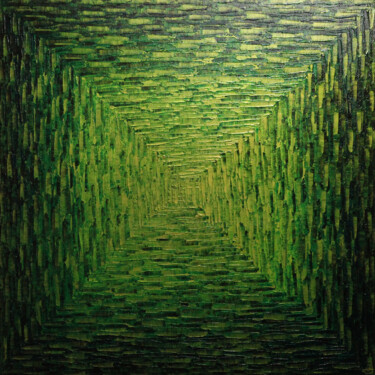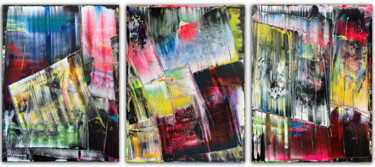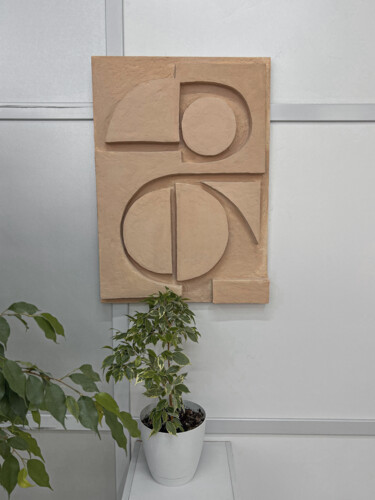Abstract art, in its most well-known narratives, is often associated with the great male masters whose names are now widely recognized: Pollock, Kandinsky, Mondrian, and others. Yet, alongside these famous figures, there are women artists who have made equally significant and sometimes revolutionary contributions, though they have remained less well-known than their male counterparts.
Female figures finally take center stage in this exploration, which, though not exhaustive, is a meaningful highlight of some of the most relevant names in the abstract figurative language. Our top 10 pays homage to extraordinary figures such as Hilma af Klint, Georgia O'Keeffe, Agnes Martin, Joan Mitchell, Helen Frankenthaler, Lee Krasner, Elaine de Kooning, Carmen Herrera, Lygia Clark, and Judy Chicago.
This text is a celebration of their "revenge": through their works, these artists have demonstrated that abstraction has never been an exclusively male domain. We will discover how their vision shaped a crucial part of the historical-artistic narrative.
Hilma af Klint, N. 7, Adulthood, 1907. Hilma af Klint Foundation
Hilma af Klint
Hilma af Klint (October 26, 1862 – October 21, 1944) was a Swedish painter and mystic, now recognized as one of the earliest abstract artists in the history of Western art. Working ahead of Kandinsky, Malevich, and Mondrian, she created paintings that explored profound spiritual concepts. Hilma af Klint's style is a unique fusion of geometry, figuration, symbolism, and spirituality. Her works, often large in scale, explored concepts of organic growth and natural processes, inspired by her scientific and botanical studies.
One of Hilma af Klint's masterpieces is "N. 7, Adulthood", part of the series "The Ten Largest" in the cycle "Paintings for the Temple". This large work, over three meters tall, combines fluid organic forms and vibrant colors like yellow, red, and green on a delicate lilac background. Recalling botanical and mathematical shapes, the painting symbolizes growth and existence. In this vital context, critic Adrian Searle recognized the influence of Darwinian theories, particularly the idea that the development of plants and natural forms follows a mathematical progression. In this sense, the presence of "stylized" numbers and letters adds further layers of symbolism.
Additionally, Mark Hudson, a scholar, noted how the curved forms and cryptic inscriptions, such as "sox, sax, sex" or "eros wu", also suggest a subtle hidden erotic charge. Finally, it's worth highlighting that the technique used for "Adulthood", painted on paper and then mounted on canvas, anticipates the preference for large formats, more commonly associated with Abstract Expressionists and often reserved for male artists.
Georgia O'Keeffe, Sunrise, 1916. Watercolor on paper.
Georgia O'Keeffe
Georgia Totto O'Keeffe (November 15, 1887 – March 6, 1986) was a pioneer of American modernism, recognized as one of the most influential figures in 20th-century art history. The artist is known for her ability to blend abstraction and representation in a way that captures the essence and power of nature. One of the distinctive aspects of her style is the use of "enlarged" forms, particularly in her flower paintings, where she focused attention on the details, transforming them into abstractions through a harmonious fusion of color and shape. Her vivid color palettes and soft lines also served to evoke, beyond the visible image, a deep sense of emotion and connection with creation.
One of her earliest and most important abstract works is the watercolor "Sunrise" (1916). Created during the period when she was teaching in South Carolina, this work on paper captures the delicacy and power of a sunrise through masterful use of color and "synthetic" form. The palette of the masterpiece features shades of red, purple, and yellow to bring to life a sky gradually lighting up, with a concentric composition that evokes the radiant energy of the sun emerging from the horizon. The vision conveys a sense of peace but also of emerging vitality, emphasized by the contrast between the intense light at the center and the darker shades at the edges.
Finally, this work is indispensable because it marks a crucial moment in O'Keeffe's career: the definitive transition of the painter towards a personal visual language, combining a sense of abstraction with the representation of the natural world.
Agnes Martin, Happy Holiday, 1999.
Agnes Martin
Agnes Bernice Martin (March 22, 1912 – December 16, 2004) was a Canadian-American abstract painter, renowned for her minimalist style and her contribution to abstract expressionism. Her works, characterized by simple grids and lines, convey a sense of serenity and spirituality, situated at the crossroads of various 20th-century artistic movements, combining elements of minimalism and Color Field painting. While these features are not figurative, they reflect a strong connection to nature, evident in the titles of her works as well as in her writings. In fact, Martin found inspiration in the simplicity of everyday life and the organic world, which she later organized into grids where soft, serene, and luminous colors were arranged. This approach also allowed the painter to explore infinite variations of color and form, capable of transmitting a spiritual and contemplative calm, in stark contrast to the austere and solitary life of the artist.
One of Agnes Martin’s most representative masterpieces is "Happy Holiday" (2000), an abstract painting divided into fourteen horizontal bands of equal width, alternating between white and peach. The lines separating the bands are hand-drawn with a pencil and a short ruler, creating a sense of lightness and simplicity typical of her approach to painting. Despite the use of a ruler, the lines actually have a trembling and irregular quality, emphasizing the importance of drawing in her work and her attention to manual detail. Finally, the base of the canvas, prepared with a layer of white gesso, gives the entire painting a vibrant luminosity, while the acrylic colors, applied in thin layers, seem to float on the surface.
Joan Mitchell, Hemlock, 1956. Painting. Whitney Museum of American Art, New York.
Joan Mitchell
Joan Mitchell (February 12, 1925 – October 30, 1992) was an American painter, renowned for her contribution to the Abstract Expressionist movement, though her work diverged from the more spontaneous approach typical of Action Painting. Her production was nonetheless marked by an emotionally intense style, influenced by landscapes she remembered and by great Post-Impressionist masters such as Henri Matisse. Joan Mitchell's brushwork stands out for its gestural intensity, combining bold colors with decisive strokes. It is also known that Mitchell planned her compositions by evoking memories, often related to nature and poetry, a method that gave her work a reflective quality that balanced improvisation with a more defined structure.
Her canvases were generally large and richly colored, often divided into multiple panels, as the artist rejected the idea of "uniformly distributed" art. As curator John Yau noted, Mitchell’s works "advanced the idea that a painting can be made of separate yet interwoven parts," a characteristic that allowed her to stand out in a male-dominated art world, making her one of the most important figures in Abstract Expressionism.
Among Mitchell's most famous masterpieces is "Hemlock" (1956), an oil painting on canvas characterized by bold gestural brushstrokes, where cool tones dominate, with whites intersecting with green and black horizontal lines, evoking a wintry evergreen landscape. In fact, "Hemlock" takes its name from the tree mentioned in Wallace Stevens' poem "Domination of Black", which was certainly a source of inspiration for the artist.
Helen Frankenthaler, Mountains and Sea, 1952. Oil and charcoal on canvas. National Gallery of Art, Washington, D.C.
Helen Frankenthaler
Helen Frankenthaler (December 12, 1928 – December 27, 2011) was one of the most influential artists of the 20th century, playing a crucial role in the history of postwar American painting. Born in Manhattan, she was introduced early on to the New York art scene, where she met figures like Jackson Pollock, Franz Kline, and Robert Motherwell, whom she later married. Although influenced by Abstract Expressionism, Frankenthaler developed her own distinctive technique, the "soak-stain," which revolutionized the use of color in painting. This process, which involved pouring diluted paint onto unprimed canvas, created luminous washes that fused with the fabric of the support itself, eliminating any illusion of three-dimensionality. While her work was initially associated with Abstract Expressionism, the artist is better known for her contribution to Color Field Painting, a movement that celebrated the use of large expanses of pure color on canvas. Despite the abstraction, her paintings were often inspired by impressions of natural landscapes, captured in their sensations and atmospheres through the use of color.
"Mountains and Sea" is considered the masterpiece that marked a decisive turning point in Helen Frankenthaler’s career, as in this 1952 painting, the artist introduced her revolutionary technique for the first time. The composition was inspired by the landscapes of Cape Breton in Nova Scotia, which Frankenthaler had visited shortly before creating the work. In this naturalistic context, color took on a central role, with washes of pink, blue, and green outlining hills, rocks, and water. Finally, it’s important to note the delicate contrast between the lightly sketched charcoal lines and the vibrant hues that expand freely across the unprimed canvas.
Lee Krasner, Gaea, 1966. Oil on canvas. The Museum of Modern Art, New York.
Lee Krasner
Lee Krasner (October 27, 1908 – June 19, 1984) was an American painter and one of the most important figures of Abstract Expressionism, primarily active in New York. After receiving academic training at the Women's Art School of Cooper Union and the National Academy of Design, she was introduced to the world of modern art through her exposure to Post-Impressionism at the Museum of Modern Art in New York City. In the 1930s, she studied with Hans Hofmann, incorporating cubist elements into her work, and during the Great Depression, she worked for the Federal Art Project. A decade later, Krasner became a prominent figure within the New York School alongside painters such as Willem de Kooning and Mark Rothko. However, her 1945 marriage to Jackson Pollock, a central figure of Abstract Expressionism, often overshadowed her career. After Pollock's tragic death in a car accident in 1956, Krasner endured a period of deep grief but continued to work with renewed artistic intensity, gaining increasing recognition in the years that followed.
In terms of style, Krasner’s work is characterized by constant evolution and exceptional artistic versatility. Though initially associated with Abstract Expressionism, she rejected the repetitiveness she perceived in the work of some of her contemporaries, such as Mark Rothko and Barnett Newman. Her desire for renewal, which she called "breaks," led her to develop new forms of artistic expression, including the famous "Little Image" series in the late 1940s, as well as her bold collages of the 1950s and her large, brightly colored canvases of the 1960s. Krasner was also one of the first artists to experiment with the "all-over" technique, inspired by the work of Piet Mondrian, which later influenced Jackson Pollock's famous drip paintings. Her art evolved without being confined to a single technique or style: her tendency to revisit and rework her own creations was evident in her practice of cutting up and repurposing old canvases to create collages, a process that reflects the influence of Henri Matisse. Moreover, Krasner sought not only to explore abstraction but also to express a deep connection with nature and the organic world.
Among the most representative works of Lee Krasner is "Gaea" (1966), a monumental oil painting on canvas that embodies her vibrant exploration of color and her profound connection to nature.
Elaine de Kooning, Bacchus #81, 1983. Georgia Museum of Art, Atene, USA.
Elaine de Kooning
Elaine de Kooning (March 12, 1918 – February 1, 1989) was an abstract expressionist and figurative painter active in the postwar period. Also known as an art critic and teacher, she was one of the most energetic and influential voices in the New York art scene. Her career was influenced by key figures of the movement, including her husband Willem de Kooning and Arshile Gorky. Although initially overshadowed by her husband's fame, Elaine de Kooning developed a personal artistic language that fused abstract and figurative elements, often portraying friends, athletes, and even a U.S. president.
In terms of style, having embraced Action Painting and its gestural, dynamic approach, she focused on capturing the energy and personality of her subjects rather than their exact likeness. In her portraits, de Kooning sought to capture the essence of a person through lively, fluid brushstrokes, avoiding purely realistic representation. This approach is also evident in her works featuring mythological subjects and primitive themes, which she often used to explore the tensions between form and movement.
"Bacchus #3" (1978), for example, is one of Elaine de Kooning's masterpieces: the large painting is characterized by vibrant greens, grays, and blues that blend across the canvas, while black lines emerge on the surface, suggesting the figure of a sculptural group, likely inspired by the Bacchus sculpture in the Jardin du Luxembourg in Paris.
Carmen Herrera, Untitled, 1952. The Museum of Modern Art, New York.
Carmen Herrera
Carmen Herrera (May 31, 1915 – February 12, 2022) was a Cuban-American painter known for her contribution to abstract and minimalist art. Born in Havana, she spent much of her life in New York, where she moved in the mid-1950s. The artist was active during a period when abstraction dominated the New York art scene, but her style did not fully align with her colleagues in the Abstract Expressionist movement. In fact, often working in isolation, her artistic language was characterized by a formal purity that combined geometry with a thoughtful and vibrant use of color. Her style is rooted in simplicity and precision, marked by sharp lines and flat fields of color, aimed at generating essential and vital compositions. Indeed, her works explore the relationship between form and color, with particular emphasis on the interactions between surfaces and spaces.
This approach connects her to movements such as hard-edge abstraction and Op Art, although her work remains unique for its rigorous formal reduction and attention to harmonic arrangement. Speaking of masterpieces, "Untitled" (1952) is one of the artist's most significant paintings. The work, created with synthetic paint on canvas, is characterized by black and white lines that cross the surface, dividing the canvas into two triangular sections. The simple yet striking composition explores the tension between order and movement, with sharp edges that suggest an almost violent vibration. Finally, the geometric shapes and color contrasts create a visual effect reminiscent of Op Art, but the energy that emanates from the work is the result of a decidedly more intuitive and experimental approach.
Lygia Clark, Planes in Modulated Surface No. 4, 1957. Formica and industrial paint on wood. The Museum of Modern Art, New York.
Lygia Clark
Lygia Clark (October 23, 1920 – April 25, 1988) was one of the most influential Brazilian artists of the 20th century, known for her abstract paintings and interactive installations. She is closely associated with the Brazilian Constructivist movement and later co-founded the Neo-Concrete movement alongside artists such as Amilcar de Castro, Franz Weissmann, and Lygia Pape. Her work was distinguished by its innovation in the interaction between artwork and audience, bringing the concept of participation in art to new levels. In fact, Clark explored principles related to sensory perception and psychological connection with the masterpiece, coming to define her work as "living experiences."
Starting in the 1970s, she increasingly focused on the therapeutic use of art, using objects and involvement as a means of addressing psychological trauma and personal experiences. For this reason, the artist progressively moved away from traditional painting to explore new modes of expression that actively involved the viewer, whom she considered an integral part of the artwork.
However, speaking of her painting work, the masterpiece "Discovery of the Organic Line" (1954) is noteworthy. While maintaining a strong geometric foundation, this piece marks the beginning of her exploration of three-dimensional space and her shift toward greater interaction with the public.
Judy Chicago, The Dinner Party, 1979.
Judy Chicago
Judy Chicago (Chicago, July 20, 1939) is one of the most influential American feminist artists of the 20th century. In the 1970s, she founded the first feminist art program in the United States at California State University, Fresno. Appropriately, her work has explored themes related to birth, creation, and the role of women in history and culture. These topics are conveyed through a style distinguished by the use of a wide range of artistic techniques, such as embroidery, ceramics, and glass—skills traditionally considered craft and often associated with women's work. Chicago consciously elevated these media, historically relegated to the margins of "high" art, incorporating them into her works as symbols of female power and creativity.
One of the central aspects of her work is the confrontation with patriarchal power structures and the reclamation of a feminine art history, highlighted through the use of precise symbolism. Indeed, her creations aim to rewrite the narrative of artistic development by shedding light on forgotten or marginalized female figures. Her most famous work, "The Dinner Party", is considered the first major masterpiece of feminist art and is permanently installed at the Elizabeth A. Sackler Center for Feminist Art at the Brooklyn Museum. The installation celebrates women's contributions to history, presenting a triangular table with 39 place settings reserved for extraordinary women from different periods of Western civilization. Each place setting features a plate decorated with floral or butterfly motifs symbolizing the vulva, and a runner embroidered with the name and image of the woman being honored.


 Olimpia Gaia Martinelli
Olimpia Gaia Martinelli























